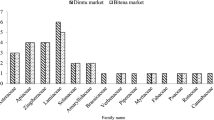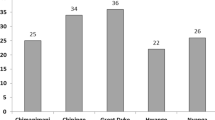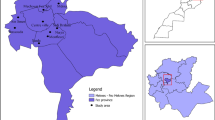Abstract
Based on independent interviews with 25 persons we report 44 edible species of plants used by the Batemi of Sale Division, Ngorongoro District, Tanzania. Thirty-one of these are specifically consumed as food; six species are chewed as thirst quenchers; seven species of gums and resins are chewed; two species are added to food as flavorants; and one species is used in the preparation of honey beer. We report 8 species used as tooth brushes by the Batemi. An additional 35 species of food and beverage plants were observed under cultivation by the Batemi. With these plants the Batemi ingest phytochemicals in a manner that could have positive health effects.
Resumen
A partir d’entrevues indépendentes avec 25 personnes, nous avons documenté 44 plantes comestibles utilisées par les Batémis du district de Ngorongoro, Tanzanie. Trente-et-une de ces plantes sont consommées comme aliment; six espéces sont mastiquées pour pallier ã la soif; sept espéces de gomme et de résine sont mastiquées; deux espéces sont ajoutées ã la nourriture pour en rehausser le goût; et une espéce est utilisée dans la fabrication de l’hydromel. Nous rapportons huit espéces utilisées comme brosses ã dents par les Batémis. De plus, 35 espéces de plantes sont documentées sous culture par les Batémis ã des fins de consommation comme aliment ou boisson. A l’aide de ces plantes les Batémis ingérent des agents phytochimiques qui pourraient avoir des effets positifs sur la santé.
Similar content being viewed by others
Literature Cited
Adams, W.M., T. Potanski andJ. E. G. Sutton. 1994. Indigenous farmer-managed irrigation in Sonjo, Tanzania. Geographical Journal 160:17–32.
Brieskorn, C.H., andP. Noble. 1982. Constituents of the essential oil of myrrh II: sesquiterpenes and furanosesquiterpenes. Planta Medica 44:87–90.
Campbell, B.M. 1987. The use of wild fruits in Zimbabwe. Economic Botany 41:375–385.
Cunningham, A.B. 1988. Collection of wild plant foods in Tembe Thonga society: a guide to Iron Age gathering activities? Annals of the Natal Museum 29:433–446.
Duwiejua, M., I. J. Zeitlin, P. G. Waterman, J. Chapman, G. J. Mhango andG. J. Provan. 1993. Anti-inflammatory activity of resins from some species of the plant family Burseraceae. Planta Medica 59:12–16.
Elvin-Lewis, M. 1986. Therapeutic rationale of plants used to treat dental infections. Pages 48–69in N. L. Etkin, ed., Plants in indigenous medicine and diet. Redgrave Publishing Company, Bedford Hills, NY.
Farah, M.H., R. Andersson, andG. Samuelsson. 1992. Microdontin A and B: two new aloin derivatives fromAloe microdonta. Planta Medica 58:88–93.
Fleuret, A. 1979. The role of wild foliage plants in the diet: a case study from Lushoto, Tanzania. Ecology of Food and Nutrition 8:87–93.
Getahun, A. 1974. The role of wild plants in the native diet in Ethiopia. Agro-Ecosystems. 1:45–56.
Glegg, C.G. 1945. Native foodstuffs in Tanganyika: The preparation and use of local foodstuffs in the Shinyanga district of Sukumaland, Tanganyika Territory. Tropical Agriculture. 22:32–38.
Glover, P.E., J. Stewart, andM. D. Gwynne. 1966. Masai and kipsigis notes on east african plants:Part II—Domestic uses of plants. East African Agricultural and Forestry Journal 32:192–199.
Gray, R.F. 1963. The Sonjo of Tanganyika. Oxford University Press, London.
Grivetti, L.E. 1979. Kalahari agro-pastoral-hunter-gatherers. The Tswana Example. Ecology of Food and Nutrition 7:235–256.
Gundidza, M., B. Sorg, andE. Hecker. 1993. A skin irritant principle from Euphorbia matabelensis Pax. Journal of Ethnopharmacology. 39:209–212.
Hasapis, X., A. J. MacLeod, andM. Moreau. 1981. Glucosinolates of nine Cruciferae and two Capparaceae species. Phytochemistry 20:2355–2358.
Iwu, M.M. 1993. Handbook of african medicinal plants. CRC Press, Boca Raton.
Johns, T. n.d. Phytochemicals as evolutionary mediators of human nutritional physiology. International Journal of Pharmacognosy. In press.
—, andL. Chapman. 1995. Phytochemicals ingested in traditional diets and medicines as modulators of energy metabolism.in J. T. Arnason and R. Mata, eds., Phytochemistry of medicinal plants. Recent Advances in Phytochemistry 29. Plenum Press, New York.
—, andJ. O. Kokwaro. 1991. Food plants of the Luo of Siaya District, Kenya. Economic Botany 45:103–113.
—,E. B. Mhoro, P. Sanaya, andE. K. Kimanani. 1994. Herbal remedies of the Batemi of Ngorongoro District, Tanzania: a quantitative appraisal. Economic Botany 48:90–95.
-,R. L. A. Mahunnah, P. Sanaya, L. Chapman, and T. Ticktinn.d. Hypocholesterolemic constituents in the diet of a traditional subsistence community, the Batemi of Ngorongoro District, Tanzania. Submitted.
Kamel M.S., K. Ohtani, M. H. Assaf, R. Kasai, M. A. El-Shanawani, K. Yamasaki, A. A. Ali, andO. Tanaka. 1992. Lignan glycosides from stems ofSalvadora persica. Phytochemistry 31:2469–2471.
Kokwaro, J.O. 1976. Medicinal plants of East Africa. East African Literature Bureau, Kampala.
Miles, C.O., A. L. Wilkins, S. C. Munday, A. Flaoyen, P. T. Holland, andB. L. Smith. 1993. Identification of insoluble salts of thβ-D-glucuronides of episarsasapogenin and epismilagenin in the bile of lambs with alveld and examination of Nartheciumossifragum, Tribulus terrestris, andPanicum miliaceum for sapogenins. Journal of Agricultural and Food Chemistry 41:914–917.
Nash, R.J., J. Beaumont, N. C. Veitch, T. Reynolds, J. Benner, C. N. G. Hughes, J. V. Dring, R. N. Bennett, andJ. E. Dellar. 1992. Phenylefhylamine and piperidine alkaloids inAloe species. Planta Medica 58:84–87.
Newman, J.L., 1975. Dimensions of the Sandawe Diet. Ecology of Food and Nutrition 4:33–39.
Ogle, B.M., andL. E. Grivetti. 1985. Legacy of the Chameleon: edible wild plants in the kingdom of Swaziland, Southern Africa. A cultural, ecological, nutritional study. Part IV-Nutritional analysis and conclusions. Ecology of Food and Nutrition 17:41–64.
Saleh, M. 1976. Phytochemical and botanical studies of Gynandropsis spp. Pharmazie 31:818–819.
Scudder, T. 1971. Gathering among African woodland savannah cultivators, a case study: The Gwembe Tonga. Manchester University Press, Manchester.
Smith, W., T. C. Meredith, and T. Johns. n.d.a. Exploring methods for rapid assessment of woody vegetation in the Batemi Valley, north-central Tanzania. Conservation Biology. Submitted.
-,T. C. Meredith, and T. Johns. n.d.b. Use and conservation of woody vegetation by the Batemi, north-central Tanzania. Economic Botany. Submitted.
Author information
Authors and Affiliations
Rights and permissions
About this article
Cite this article
Johns, T., Mhoro, E.B. & Sanaya, P. Food plants and masticants of the batemi of Ngorongoro District, Tanzania1. Econ Bot 50, 115–121 (1996). https://doi.org/10.1007/BF02862116
Received:
Accepted:
Issue Date:
DOI: https://doi.org/10.1007/BF02862116




